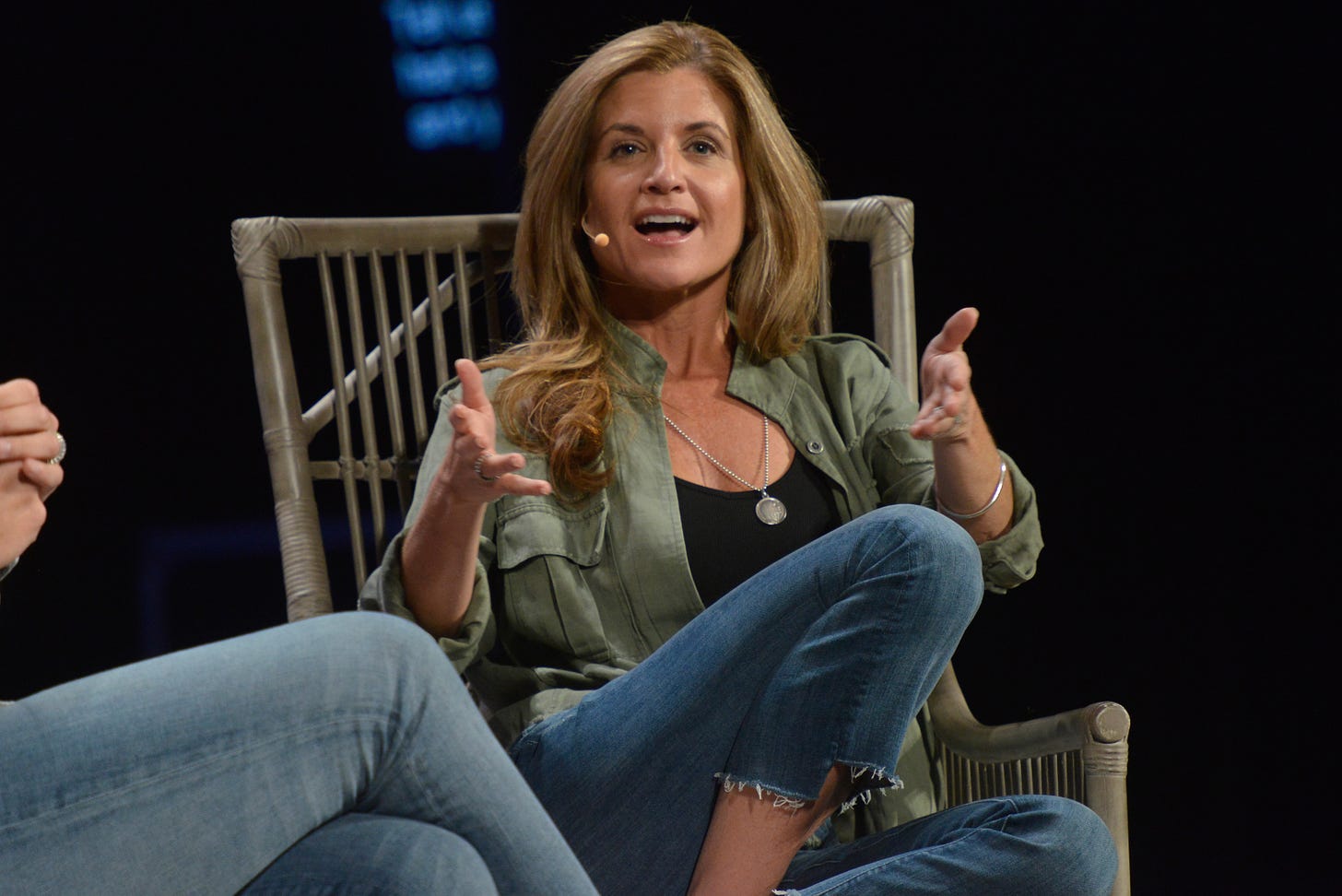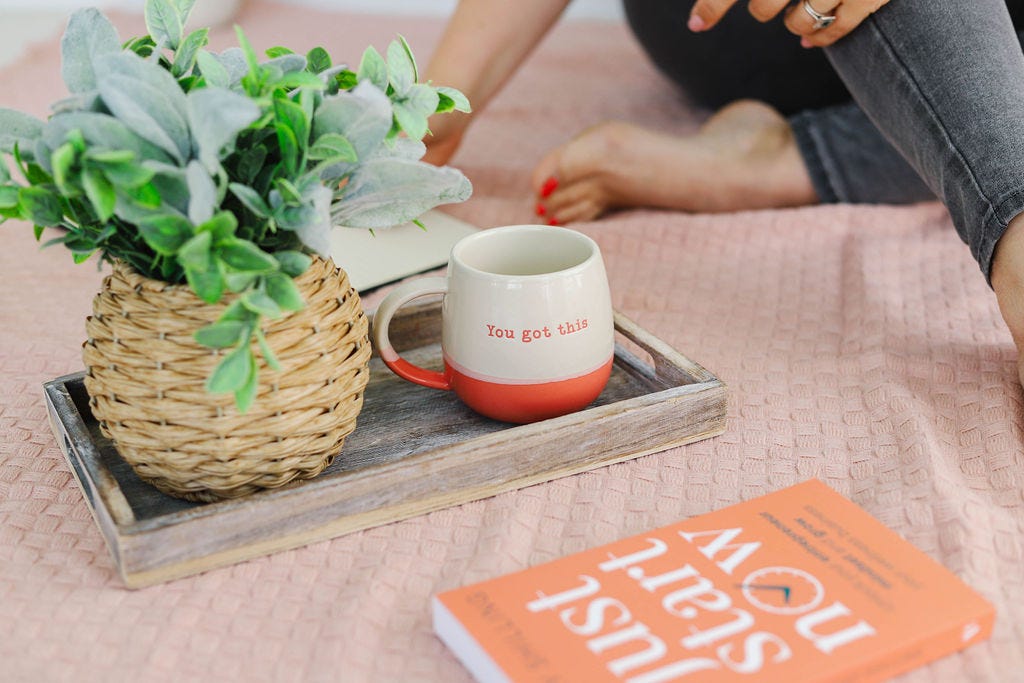What Glennon Doyle’s time on Substack teaches us about self-trust
Glennon Doyle left Substack. The reactions say more about us.

Last month Glennon Doyle joined and then left Substack due to criticism and the feeling of being unsafe and unappreciated on the platform.
Many people here wrote about it, for example Emily Barnett in this piece called ‘Was Glennon Doyle bullied off Substack?’
This article was a response to a particularly popular criticism of Doyle’s presence here in Notes from Priscilla Harvey, in what she called an Open Letter to Glennon Doyle.
If you’re a Substack aficionado I’m sure you read these or similar critiques of Doyle’s time on the platform, so I won’t repeat them here or take them apart line by line – feel free to read the two I’ve linked to in order to get an overview if you missed this storm in a Substack teacup!
But what I do want to do is reflect my thoughts having gone down that rabbit hole in the week it all happened and read many, many comments and opinions, as to what this all means for us.
What does Glennon Doyle arriving and then swiftly departing from Substack, say about how much we trust ourselves to show up and be authentic and say what we want in the world, and what we make it mean when others do the same?
Because my personal view is that if people think Doyle announced her arrival and was “too much” on the platform, that is their problem and not Glennon’s.
I don’t believe she owes anybody anything, whether it’s on Substack or any other platform she shows up on, to appear quietly, dim her light, do it the way others have, or “highlight others” (read: smaller earning, lower follower number writers) instead of showcasing her own work.
And she is 100% entitled to have a paywall from day 1.
If we find how someone else chooses to conduct themselves: how they earn money, the company they keep and leverage and the way they market themselves - obnoxious, uncomfortable or triggering, the work is for us to do to uncover why. Not to tell her she’s doing it ‘wrong.’
I understand that we want to make Substack a friendly and supportive platform that raises up great writers and voices. But we don’t achieve that by loudly criticising how others use it. We do that by being better examples ourselves of what we want to see.
Let’s break it down as to why these sorts of critical responses say a lot about our own self-trust and how we can react differently when we see someone arrive in their marketing in a blaze of triggering glory (and see some seismic shifts in our own business as a result):
1. Other people’s visibility is a mirror you need to start looking in
When someone shows up unapologetically visible and self-assured (as Glennon did, launching with a paywall, team, and clarity of voice), it often triggers others’ unprocessed self-doubt.
The criticism she faced reflects less about her choices in the way she started to use Substack as a way to connect with her audience, and more about what her confidence revealed in others: their own hesitation, insecurity, or resentment about not allowing themselves the same boldness.
If you don’t like how someone else is getting in front of audiences, what is that saying about how you feel about the way you are doing it (or not doing it) in your business?
This is said with absolute compassion. Because while Doyle’s use of Substack didn’t irk me, there’s definitely other ways solopreneurs trigger the hell out of me which I use for reflection.
For example, I am deeply uncomfortable with the way some people share their wins. Particularly their business ones.
Constantly saying how great their latest launch was, how they’re living their dream, how incredible the response was to their new offer, how quickly people in their audience are turning into customers…. Etc. etc.
It really gives me a sucker punch to the gut. My brain goes into overdrive. It puts me into such a negative spin.
But what I don’t do – which I absolutely did in the past - is think they’re doing it wrong.
I don’t sit and complain about it, I don’t doom scroll through their content, rolling my eyes and feeling depressed and I don’t moan to a business bestie about how their marketing feels disingenuous and gives me the ‘ick.
I look in the mirror.
I use my TRUST tools (read more about these here) to reflect on where stories and beliefs might have come up for me that tooting my own horn and celebrating wins of all sizes, in public, is something not to do.
When I look in that mirror I have to accept that the stories that I carry are things like:
Business owners who shout about their success are ripping people off and are a disaster behind the scenes (I don’t want to be lumped with that)
If I said how well I was doing then I would be judged and criticised
People who say they’re doing really well are all liars and their successes aren’t real or sustainable (I don’t want people to think that about me)
Staying modest and accessible means I’m connected to my people and they’ll think I’m nice and humble
These are all stories and beliefs I get to change. The work is for me to identify and change these beliefs. Not to tell someone else they should change how they do things.
2. Self-trust isn’t quiet or palatable.
This story of Glennon Doyle’s experience on Substack reminders us that self-trust doesn’t always look like humility or deference.
I call my Substack The Business of Self-Trust and that can feel like a nice, warm, inner, silent glow and assurance. And it can be that sometimes.
But self-trust can also be loud, clear, and self-honouring.
And that loud, clear and self-honouring version (which Glennon Doyle’s showed up as when she landed in this space) can offend those who’ve been taught to stay small, or who expect others to pay dues in the same way they did.
Something to ask ourselves then is: Why do we equate “earning a place” with struggle or self-minimisation?
Why did Glennon Doyle have to sneak on to Substack quietly and read everyone else’s content for months and not take a penny, before publishing and charging for her own?
And don’t get me wrong, wouldn’t it have been lovely?! For Doyle to join Substack and make loads of other tiny writers go viral and get millions of hits and paid subscriptions thanks to her championing?! I’d have loved to see that too!
But she doesn’t owe us anything.
Doyle trusted herself to show up how she wanted and in a way she thought her audience would find value and to maximise her engagement and new reach. It was savvy, it was bold, it was claiming her expertise and authority.
I’m sure she would down the line have shared and championed other people’s content that she read. But we chased her off the platform too soon to ever know, because we’re cross she didn’t do that for months first. Before having the audacity to focus on her own writing and value first.
What if no-one, not the Substack writer with 1 subscriber, or Heather Cox with 2.5M, had to “earn their place” here?
What if we all just show up and create what we want in the way that we want?
As long as it’s not actively harming anyone else, why does showing up and making an impact have to involve struggle and playing small? (Answer: usually because we’ve been told this sort of minimisation of who we are and what we think is the only way to gain approval in the world. And that’s just a story.).
3. She trusted herself enough to walk away – and that’s triggering.
Whilst a lot has naturally been said about the way Glennon Doyle arrived and conducted herself in her short time on Substack, there’s a lot to learn about self-trust when she decided fairly rapidly to leave.
Glennon didn’t stay to prove a point, to smooth things over, or to tolerate a space that felt unsafe.
That’s self-trust in action too. Not just showing up powerfully, but leaving powerfully.
Self-trust isn’t just visibility and being seen. It’s also where you don’t go and where you remove yourself from and where you set boundaries to protect yourself.
Even if it affects your relationships or your income.
Doyle’s example to us all is that self-trust means refusing to contort yourself to belong somewhere that won’t hold you. Or makes you feel negative.
I think this is a great one for solopreneurs to reflect on, particularly around their use of social media or marketing platforms. I can’t tell you the amount of solo business owners I coach that when I suggest they should leave Instagram because it makes them feel terrible, feels hard, feels judgemental and brings them down, immediately jump to “oh well I feel I should be there and my customers might find me, and I should just get over it.”
Glennon Doyle fully trusted the experiment of Substack initially - I’m sure she was sold the virtues of the platform by others – so she took the plunge.
But she also trusted she’s going to be fine thanks very much, marketing and connecting with her audience and continuing to grow her wildly successful and impactful business without it, when it didn’t feel right and safe to her.
I know many of us don’t feel we have the luxury of that choice with our marketing platforms. But the truth is we do.
4. We resent ease and readiness.
Much of the backlash about Doyle’s time on Substack seems rooted in Glennon’s readiness - that she arrived with an audience, clarity, a team, and payment system.
In a culture that often idolises scrappiness and struggle, ease and preparation can look threatening.
I’m British – we love an underdog.
I also live in Ireland – a place where there’s even more love for the smaller David against the Goliaths in these sorts of battles.
But whilst we think this is endearing and heartwarming to be a bit clueless and make it up as we go, it does meant that we sometimes distrust or punish others for moving forward with confidence and structure, especially if we haven’t given ourselves permission to do the same.
A huge amount of my coaching with solopreneurs centres around organisation, structuring time, avoiding procrastination and questioning “I know what I want to do, why aren’t I doing it?”
The best question to ask if you’re stuck like that, or watching someone like Glennon Doyle go out with a strong confident plan and execute it, is: what am I afraid will happen if I have a plan and follow through on it?
I am guessing from what happened, that Doyle had asked herself that. That she analysed the risks of joining Substack, she worked out what ones were just stories and beliefs in her head, and then she went for it. Or hey, maybe she’s done enough of the inner work that she only saw the opportunities and benefits of leaping into something new and didn’t hesitate!
But what she clearly didn’t do was wrap herself in knots about signing up and posting. She landed, she announced, she shared, she did it her way (SING IT FRANK! 🎤) and when she realised that the risks became real and something she wanted to avoid, she made the decision to remove herself.
If we can’t respect that ease and readiness, again… it’s time to get out the mirror and see what that says about us and our beliefs.
5. Women’s self-trust is still radical.
This entire incident underscores how even now, a woman owning her power, presence, and profitability is met with suspicion.
And I’m not saying this to cast shade on those who’s reaction to Doyle’s arrival on Substack was “couldn’t she have taken in the culture here first?” or “she’s jumping to the front of the line.”
It’s completely and utterly understandable that those are our first responses. Because seeing someone who totally and utterly trusts themselves and shows up the way they want, is still policed and punished, judged and bemoaned, even by other women.
And it’s often cleverly masked and couched in such a way that it doesn’t look like judgement or criticism. It cloaks envy or insecurity in moral language. e.g., “She should have highlighted others first,” “She’s taking up too much space,” etc.
The protective part of us, I call it the Safety Guardian (you can read about how I met mine here), is an unbelievable story teller and shape shifter. It will spin you any line, story or belief to keep you safe from experiencing risks and that extends to watching someone else show up in a way that the real ‘you’ would love to do, but the protective part of you screams too loudly “NO DON’T DO IT!”
Self-doubt then can often expresses itself through a sense of fairness or judgment that has little to do with ethics and more to do with discomfort and risk avoidance. It’s basically this cycle:
1. Glennon Doyle shows up unashamedly on Substack
2. Protective Safety Guardian reads this as an example of bold audacity with massive possible risk (judgement, criticism, failure, disappointment etc.)
3. Other people criticise and judge (sometimes disguised in moral language) and you read it endlessly so it drips into your subconscious
4. You judge or criticise what she does, either quietly internally, or externally liking and commenting
5. Glennon Doyle’s time on Substack becomes concrete evidence to your Safety Guardian that it is absolutely not safe at all to show up, be yourself, make money and say what you want.
6. The cycle continues with this hard-wiring, so you avoid being you and being visible.
Let’s break that cycle.
Let’s get out of these toxic habits of reading other people’s ability to do the damn thing, as a threat to us or examples of how bold moves get terrible negative outcomes.
Let’s choose to make Glennon Doyle’s short time on Substack mean something else.
That trusting yourself and showing up how you want is needed, right and that you cannot please all the people all the time. But what you can do is trust yourself to give it a go, and deal with the consequences, whatever they are.
This has been an interesting piece for me to write and reflect on because I’m currently inside a 30 day challenge to step up and make changes in how I see myself, where I am being asked a lot of similar questions.
So let’s do this together. And ask ourselves:
Where do you dim your light to avoid negative reactions, like the one Glennon Doyle experienced?
Where are you waiting to be palatable before you show up?
Where are you assuming you need to “earn” your place in small, acceptable increments?
What would showing up with full trust actually look like?
And the deep work then goes on to ask:
What am I afraid will happen if I showed up in that way? And what do I need to believe in order for that perceived risk to stop holding me back?
Let me know what your answers are in the comments!
You can find out more about working with me here.
Join the Self-Belief Business Experiment
Get an inside look at my most personal journey yet.
The Self-Belief Business Experiment is a raw, honest exploration of rebuilding confidence and transforming my business from the inside out.
Sign up to follow along as I share real struggles, small wins, and the ups and downs of tackling my own self-doubt head-on.
This isn’t a polished success story—it’s a transparent look at what it truly takes to build a business backed by belief.






Great piece!
Excellent Insights!